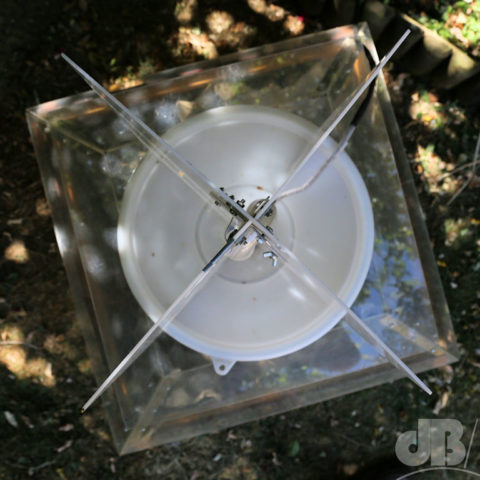My very good friend Rob, former bigMouth chorister, cabinet maker, luthier, painter, photographer, and, as it turns out, amateur lepidopterist built himself a moth trap back in the mid-2000s to entertain his children.
You set the trap up to do its job overnight. It is basically a sealed wooden box full of egg trays, with a big funnel as a collector and an ultraviolet lamp above as an attractor. At night, the flying creatures are attracted to the lamp, find themselves perambulating down the funnel and into the box, and roosting in the egg trays.

There they will happily stay until dawn, when the amateur lepidopterist will pay a visit to see what lurks within, setting them all free again after a few observations are made and photos taken, preferably into undergrowth and bushes some distance away from the trapping site. You can see some of the snaps I took at Rob’s early this morning in a Facebook gallery entitled Mothley Crew, hopefully I will have more species to display tomorrow.
I paid Rob a visit early this morning, by invitation, to see what kind of haul he might have had on a sultry July night. Daytime temperatures have been 30 degrees Celsius plus and nothing lower than about 25 at night. There were plenty of flies and beetles in the trap and no smaller number of moths. Moths of all sizes from tiny little specimens, through White and Buff Ermines, and Large Yellow Underwings 20 millimetres or so from antennae to tail, and at least one much bigger Poplar Hawk Moth.
I snapped a few close-ups with my phone camera while Rob set them free into his garden shrubberies to fly another night or be snaffled up by Pipistrelle Bats. It seemed rather churlish not to offer to borrow the trap to see what kind of mothley crew we might have in our back garden and save a few from the local bats, just for a night. So, almost midday, the trap is set, just need to wait until dark, switch on the lamp, and spend an excitedly restless night dreaming of Elephant Hawk Moths, Netted Carpets, Brimstones, and Angle Shades.
Incidentally, that lamp…it looks like a U-shaped fluorescent tube about 300 mm in length. It’s labelled as an “actinic lamp”. Actinic from the Greek for a ray or beam and pertaining to photography and other areas where light is important. A non-actinic light, such as a red light used in a photography dark room, will not fog photographic film and triggers no photobiological nor photochemical reactions. An actinic light, as used in Rob’s homemade Robinson-type moth trap is the opposite. It’s a full-on bright, white light that reaches deeper into the high-energy blue end of the visible spectrum and is thus highly visible to light-seeking invertebrates.

In terms of etymology, chemist readers will recall the radioactive (beta emitting) element actinium and its relatives the actinides, which will fog photographic film, and much more besides…